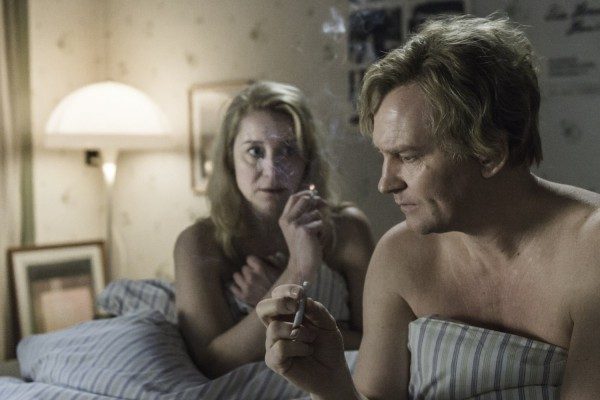

Thomas Vinterberg (The Hunt, Far From the Madding Crowd) has once again proven himself to be the king of the dinner table in his latest film The Commune. Exploring the shifting dynamics of the group versus the individual, and the blurred lines between, the Danish filmmaker has created a film that embodies the concept visually, dramatically, comedically, and narratively through the unique perspectives of his characters. Vinterberg has an obvious knack for framing and uses it to elegantly challenge human nature within relationships. His narrative is not without flaw, but it is more difficult to fault him there than to praise him for his visual mastery.
The Commune follows Erik (Ulrich Thomsen) and Anna (Trine Dyrholm), a married couple in the 1970s who come into possession of Erik’s large childhood home after his father dies. Erik, worried about money, and Anna, wanting a fun lifestyle change, decide to convert the family home into a commune, inviting a few known friends, and a couple unknown strangers to live with them and share in the keeping of the home along with their teenage daughter. The commune’s peaceful democracy runs amok after Erik begins an affair with one of his university students, and Anna determinedly tries to hold the group together despite her mounting marital issues.
One particular line of dialogue sticks out in the film: “the end result of anarchy is order.” It is in this thought that the film finds its thematic stasis. Vinterberg’s commune comes to represent a wide variety of social facets and disorders, showing the dichotomic nature of human contact and the way it can both comfort and isolate an individual; or the slippery idea of ownership in regards to possessions like a home, or in terms of a husband or wife. In all, the commune stands in as a microcosm of human relationships, focusing on our essential need for communication, respect, and compassion above all else in order to live in peace. The film, on par with the constant flow of discussion among its characters, opens the floor to the audience in working through the ideas that can make an unlikely group of people come and fit together, as well as work through questions about monogamy and balance personal relationships between the self, the couple, and the group.
Vinterberg does not necessarily give the audience an answer, but instead takes them by surprise at several turns, allowing these questions to breathe through his characters. The storyline between Erik, Anna, and Erik’s new girlfriend Emma (Helene Reingaard Neuman) is remarkable in its twists. Anna, who is the one originally looking for a change in her relationship with Erik, gets a lot more than she bargained for; and when she is also looking for a new sense of togetherness through diversity in the commune, this intention gets taken to its extremes. What follows is an intriguing look at the isolating and solitary vestiges made possible by the chaotic application of togetherness.
Just as the film shows how the commune can isolate, it equally portrays its power of inclusion. The structure and interweaving relationships of the group have the ability to heal and be therapeutic, as well as create a community of diverse, intellectual people. While focusing on the central love triangle, the narrative does miss an opportunity to further showcase the inner lives of the other rich characters living at the house. There is a polyamorous couple with a young son who has a heart condition; there is a foreign drifter type; there is an alpha male; and at the center of all this is Erik and Anna’s teenage daughter learning about love, sex, and friendship for maybe the first time in this unconventional microcosm of human relation (although it’s pretty appropriate for the ‘70s).
Bringing all of this together is Vinterberg’s warm, intimate, and revelatory style. He starts big, like the quiet exterior of the beautiful house, and brings the audience into the intimate space of the home — for Vinterberg, that is the dinner table. We’ve seen it in his films The Hunt and Far From the Madding Crowd, and his ability to use this meeting space as a great solidifier — a tool for communication, healing, bonding, and community. In a group of varying people sharing close quarters and differing opinions, the dinner table normalizes and highlights their shared human connection and Vinterberg taps into this idea in his visibly unique approach to framing and lighting.
Verdict: 3 out of 5
The individual pieces of The Commune come together quite nicely, much like the characters themselves. Vinterberg’s exploration into connection, communication, and unconventional relationships is inquisitive and intriguing, and does well to invite the audience into the discussion. While the troubles of Erik and Anna are compelling as a focused product of the commune lifestyle, they ultimately take away from themes of inclusion, keeping a mystery the inner lives of his other characters.



